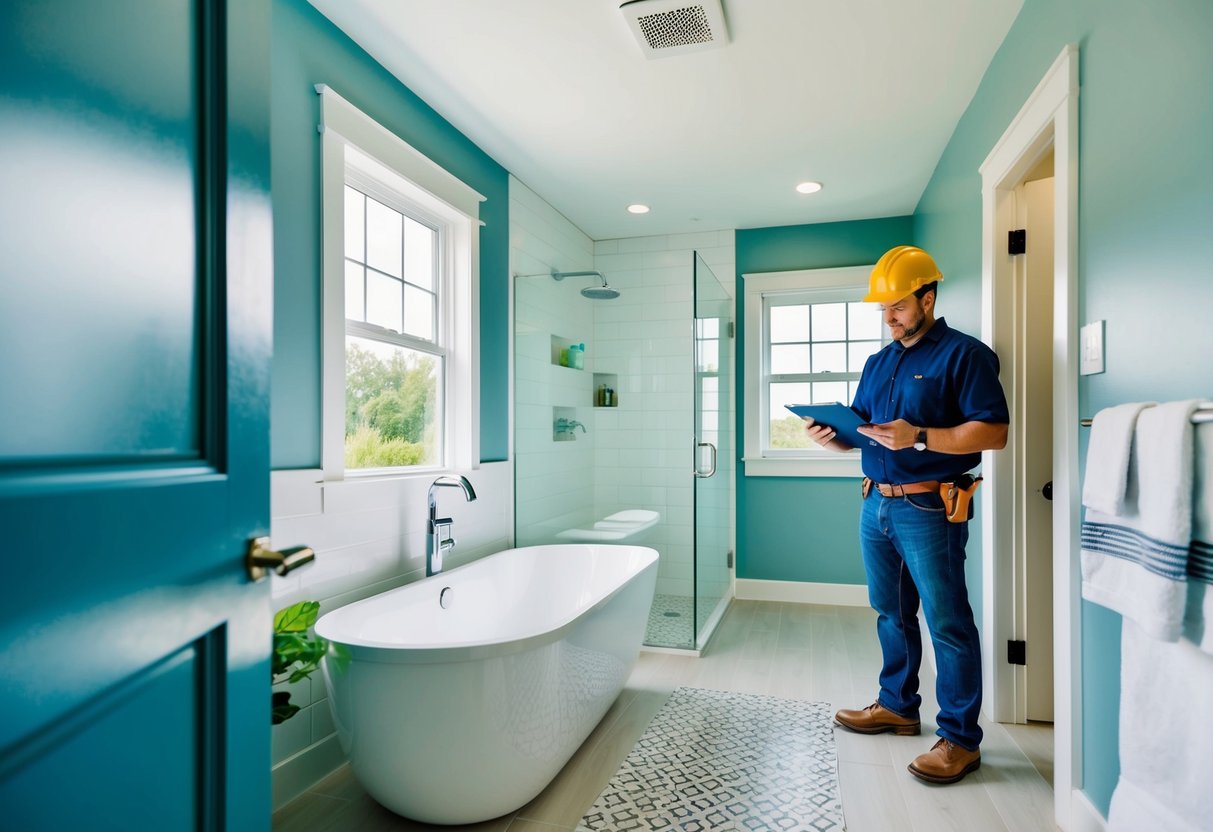Finding good tenants for your rental property can make or break your investment.
By presenting your property well, advertising effectively, and conducting thorough background checks, you can attract quality tenants who will care for your property and pay rent on time.

Start by making sure your property looks its best. Clean, declutter, and fix any maintenance issues before showing it to potential tenants. This will help you attract responsible renters who value a well-kept home.
Next, set a competitive rent price and create a compelling listing. Use high-quality photos and write a clear description that highlights your property’s best features.
Advertise on popular real estate websites, social media, and local newspapers to reach a wide pool of applicants.
Key Takeaways
- Present your property in top condition to attract quality tenants
- Use a mix of online and traditional advertising methods to reach more potential renters
- Screen tenants carefully through background checks and references
Understanding the Rental Market

Knowing your local rental market is key to finding good tenants. It helps you price your property right and attract the best renters. Let’s look at how to analyse the market and set fair rent.
Analysing Demand and Supply
Check how many rentals are on offer in your area. Look at similar properties to yours. Are there lots of vacant flats or houses? This tells you about supply.
For demand, see how long listings stay up before they’re rented.
Look at who’s renting in your neighbourhood. Are they students, families, or young pros? This affects what renters want.
Check if new flats or jobs are coming to the area. These can change demand.
Local schools matter too. Good schools often mean more families want to rent nearby. Keep an eye on school ratings and zones.
Setting the Right Rent
Use what you’ve learned about supply and demand to set your rent. If there are lots of empty rentals, you might need to charge less. If rentals are scarce, you can ask for more.
Look at rents for similar properties. Make sure your price matches what others charge.
Think about your property’s pros and cons. A fresh paint job or new kitchen might let you charge more.
Don’t set the rent too high. It’s better to have a good tenant paying slightly less than no tenant at all. But don’t go too low either. You need to cover your costs and make some profit.
Creating a Compelling Listing
A great listing catches the eye and shares key details about your rental. It’s your chance to make a strong first impression on potential tenants.
Property Photography
Good photos are crucial for your rental listing.
Hire a professional photographer to capture your property’s best features. Make sure the space is clean and tidy before the shoot.
Ask the photographer to take photos in natural light when possible. Get shots of each room, plus any outdoor areas like gardens or balconies.
Include photos of standout features like new appliances or a renovated kitchen. A floor plan can help tenants picture the layout.
Consider adding a virtual tour to really showcase the space. Quality images will help your listing stand out and attract more interest.
Crafting a Detailed Description
Write a clear, honest description of your rental. Start with the basics like number of bedrooms, bathrooms and parking spots.
Mention the property type (house, unit, etc.) and its location. List key amenities such as air conditioning, dishwasher or built-in wardrobes.
Describe the local area too. Are there shops, parks or public transport nearby? Be specific about distances. For example: “5-minute walk to train station, local shops 500 metres away”.
Keep your writing simple and easy to read. Use short sentences and bullet points for important details. Avoid jargon or fancy words that might confuse people.
Highlighting Unique Selling Points
Make your property stand out by focusing on its best features. Do you allow pets? Mention it prominently. Is there a great view or a newly renovated bathroom? Put that info up front.
Think about what makes your rental special. It could be:
- A quiet location
- Lots of natural light
- A big backyard
- Recent upgrades or new appliances
- Flexible lease terms
Be sure to mention any included utilities or services like internet. If you offer perks like a welcome hamper for new tenants, add that too. These extras can make your listing more appealing and help you find quality tenants faster.
Effective Advertising Strategies

Finding good tenants starts with smart advertising. The right mix of online and offline methods can help you reach a wide pool of potential renters quickly.
Utilising Online Rental Platforms
Popular websites like Zillow, Rent.com, and Zumper are great places to list your property. These sites get lots of traffic from people looking for rentals.
Make sure your listing has clear photos and a detailed description. Include key info like rent, number of bedrooms, and available move-in dates.
Trulia is another good option. It lets you showcase your property’s best features and nearby amenities. You can also set up virtual tours, which many renters find helpful.
Don’t forget about Facebook Marketplace. It’s free and can help you reach locals who might be interested in your rental.
Expanding Reach Through Social Media
Social media can boost your rental’s visibility. Create eye-catching posts about your property on Facebook, Instagram, and Twitter. Use high-quality photos and videos to show off the best parts of your rental.
Ask friends and followers to share your posts. This can help you tap into their networks and find potential tenants through word of mouth.
You can also join local Facebook groups focused on housing or rentals. These groups often allow members to post about available properties.
Traditional Advertising Methods
While online methods are popular, don’t overlook traditional ways to advertise.
Hosting an open house can let interested renters see the property in person. This can help you find tenants who are serious about renting.
Put up flyers on community bulletin boards at local shops, cafes, and libraries. Include tear-off strips with your contact info.
Newspaper ads can still be effective, especially in smaller towns or for reaching older renters. Keep the ad short and to the point, highlighting key features and how to contact you.
Word of mouth is powerful. Let your friends, family, and current tenants know you have a vacancy. They might know someone looking for a place to rent.
Tenant Screening Process

Finding good tenants starts with a thorough screening process. A careful review of applications, background checks, and interviews helps you choose reliable renters for your property.
Initial Application Review
Start by creating a detailed rental application form. Ask for basic info like name, contact details, and current address. Include questions about employment, income, and rental history. Request references from past landlords and employers.
Look for red flags as you review applications:
- Incomplete or inconsistent info
- Short-term employment history
- Frequent moves
- Low income compared to rent
Set clear criteria for approving tenants. This might include minimum income levels or credit scores. Apply these standards fairly to all applicants to avoid discrimination claims.
Conducting Background and Credit Checks
Background checks reveal crucial info about potential tenants. Get written permission before running any checks.
Key areas to check:
- Credit report and score
- Criminal history
- Eviction records
- Employment verification
Credit reports show payment history and debt levels. Look for a steady pattern of on-time payments. Be wary of lots of late payments or maxed-out credit cards.
Criminal checks can uncover serious offences. Focus on crimes that could impact tenant suitability, like property damage or violence.
Eviction records indicate past rental issues. Even one eviction is a big red flag.
Interviewing and Asking the Right Questions
Phone or in-person interviews let you assess applicants directly. Prepare a list of questions to ask each candidate.
Good questions to ask:
- Why are you moving?
- How long do you plan to stay?
- Do you have pets?
- What’s your typical schedule?
- Have you ever broken a lease?
Pay attention to how they communicate. Are they polite and professional? Do they seem honest and open?
Ask about lifestyle factors that could affect neighbours, like smoking or loud hobbies. Explain any rules or restrictions clearly.
Assessing Financial Stability and History
Check that applicants can afford the rent comfortably. Most experts suggest rent should be no more than 30% of income.
Ways to verify income:
- Recent payslips
- Bank statements
- Tax returns
- Employer confirmation
Look for steady employment and reliable income sources. Self-employed applicants may need extra scrutiny.
Review their rental history closely. Contact previous landlords to ask about:
- Payment habits
- Property care
- Neighbour complaints
- Lease compliance
Be wary if an applicant can’t provide landlord references or has gaps in their rental history.
Legal Considerations and Compliance

Navigating the legal aspects of rental properties is crucial for landlords. It helps protect your interests and ensures fair treatment of tenants.
Understanding Fair Housing Laws
Fair housing laws aim to prevent discrimination in rental housing. As a landlord, you must treat all potential tenants equally. This means you can’t refuse to rent to someone based on their race, colour, national origin, religion, sex, family status, or disability.
You need to be careful about the questions you ask applicants. Stick to queries about income, employment, and rental history. Avoid asking about personal matters not related to tenancy.
It’s wise to keep detailed records of your tenant selection process. This can help if you face discrimination claims later.
Drafting a Comprehensive Lease Agreement
A solid lease agreement is key to a smooth landlord-tenant relationship. It should clearly spell out the rights and duties of both parties.
Your lease should cover:
- Rent amount and due date
- Security deposit details
- Maintenance responsibilities
- Rules about pets, smoking, and guests
- Reasons for ending the lease
It’s smart to have a property manager or real estate agent review your lease. They can spot any missing items or legal issues.
Make sure your lease complies with local laws. Some areas have strict rules about what you can include in a rental agreement.
Maintaining Relationships with Tenants

Good tenant relationships are key to a smooth rental experience. Clear communication, easy rent payments, and prompt repairs keep both landlords and tenants happy.
Ensuring Clear Communication
Set up clear communication channels with your tenants. Give them your phone number and email address. Respond quickly to their messages, even if it’s just to say you’ll look into the issue.
Use a mix of methods to stay in touch. Face-to-face chats build rapport, while emails create a paper trail. Text messages work well for quick updates.
Make sure tenants know how to reach you in emergencies. Give them a backup contact for times you’re not available.
Regular check-ins can prevent small issues from becoming big problems. A quick “How’s everything going?” can make tenants feel valued.
Streamlining Rent Collection
Make paying rent easy for your tenants. Offer online payment options if possible. This saves time for both you and your tenants.
Set clear due dates and late fee policies. Put these in writing in the lease agreement. Send friendly reminders a few days before rent is due.
Be understanding if a good tenant has a one-off late payment. But don’t let late payments become a habit. Address the issue quickly if it happens more than once.
Consider offering a small discount for early payments. This can motivate tenants to pay on time or even early.
Managing Repairs and Maintenance
React quickly to repair requests. Even if you can’t fix the problem right away, let the tenant know you’re working on it.
Give them a timeline for when the repair will be done.
Do regular property inspections. This helps you catch small issues before they become big, expensive problems.
It also shows tenants you care about the property.
When doing repairs, try to schedule them at times that suit your tenants.
Give plenty of notice before entering the property.
Consider using property management software to track repair requests and maintenance schedules.
This helps you stay organised and ensures nothing falls through the cracks.
Utilising Technology for Property Management

Tech tools can make managing your rental property much easier. They help you stay organised, save time, and communicate better with tenants.
Adopting Property Management Tools
Property management tools are a game-changer for landlords. They let you handle tasks from your computer or phone.
You can use these tools to:
- Screen tenants quickly
- Collect rent online
- Track maintenance requests
- Store important documents
Look for all-in-one apps that cover most of your needs. Many offer free trials so you can test them out.
Some popular options include:
- AppFolio
- Buildium
- TenantCloud
These tools often have tenant portals too. Tenants can pay rent, report issues, and view their lease through the app.
Leveraging Online Resources for Reporting and Accounting
Online resources make reporting and accounting much simpler. You don’t need to be a maths whiz to keep your books in order.
Start with a good spreadsheet template for rental income and expenses. You can find free ones online or make your own.
For more features, try accounting software like:
- Xero
- QuickBooks
- MYOB
These programs can:
- Track rent payments
- Generate financial reports
- Help with tax prep
Many link to your bank accounts to import transactions automatically. This saves time and reduces errors in your bookkeeping.
For tenant screening, use online rental application forms. They make it easy to collect and review applicant info.
Sites like Apartment List can help you advertise your property and find tenants too.
Handling Tenant Turnover
Tenant turnover is a normal part of property management. It can be costly and time-consuming, but with the right approach, you can make the process smoother and more efficient.
Planning for Vacancies
Start planning for vacancies before your tenants move out. Give yourself enough time to find new renters.
Make a checklist of tasks to complete between tenants. This might include cleaning, repairs, and updates to the property.
Set aside some money for these tasks. You may need to paint walls or replace carpets. Having funds ready will help you act quickly.
Think about the best time to list your property. In many areas, spring and summer are busy rental seasons. If possible, time your lease end dates to match these periods.
Consider offering incentives for longer leases. This can help reduce turnover. You might offer a small rent discount for a two-year lease instead of one.
Minimising Property Damage and Loss
Do a thorough inspection when tenants move out. Take photos and notes. Compare this to the condition when they moved in. This helps you spot any damage beyond normal wear and tear.
Use the security deposit wisely. It can cover unpaid rent or repair costs. But be fair – don’t charge for minor issues.
Act quickly on repairs. Fix any problems before new tenants move in. This prevents small issues from becoming big, costly ones.
Screen new tenants carefully. Good tenants are less likely to cause damage. Check references and do background checks.
Consider updating your lease agreement. Include clear rules about property care. This can help prevent future damage.
Frequently Asked Questions

Finding good tenants involves careful screening and effective property marketing. These questions cover key aspects of the tenant selection process for landlords.
What strategies can landlords employ to attract top-quality tenants?
Keep your property well-maintained and clean. Make any needed repairs before showing it.
Take high-quality photos that highlight the property’s best features.
Offer competitive rent prices based on the local market. Consider including attractive amenities like internet or a gym membership to stand out.
What are the most critical factors a landlord should evaluate when choosing a tenant?
Check the tenant’s rental history and references from past landlords. Review their employment status and income to ensure they can afford the rent.
Look at their credit score and any history of late payments. Consider their lifestyle and whether it fits with your property and neighbourhood.
How can property owners effectively screen potential tenants?
Use a detailed rental application form. Ask for proof of income, such as payslips or bank statements.
Contact previous landlords to verify their tenancy. Run a background check to uncover any criminal history or past evictions.
What are the legal considerations for selecting tenants in Australia?
Avoid discrimination based on race, religion, gender, or other protected characteristics. Familiarise yourself with state and federal anti-discrimination laws.
Be consistent in your screening process for all applicants. Keep records of your selection criteria and reasons for accepting or rejecting tenants.
Where can landlords find reliable information on prospective tenants?
Use reputable tenant screening services. These can provide credit reports, background checks, and rental history information.
Ask for payslips or employment verification directly from the tenant’s employer. Check public records for any legal issues or bankruptcies.
In what ways can landlords advertise their rental properties to maximise exposure to ideal tenants?
List your property on popular real estate websites.
Use social media platforms to reach a wider audience.
Put up ‘For Rent’ signs in the property’s front yard.
Advertise in local newspapers or community boards.
Consider working with a property manager who has access to a large pool of potential tenants.








